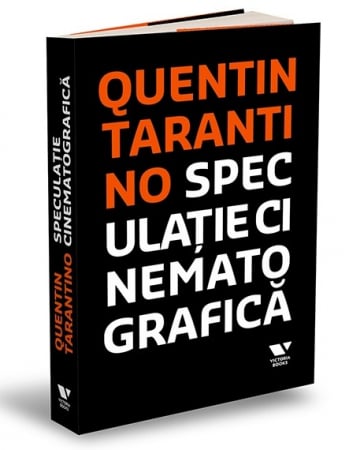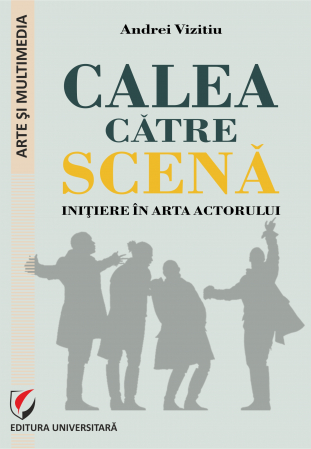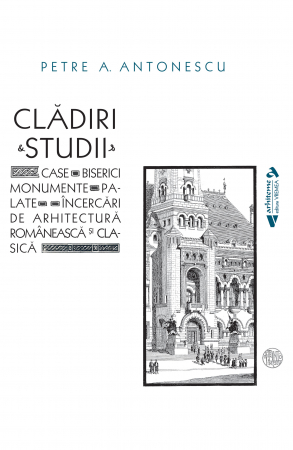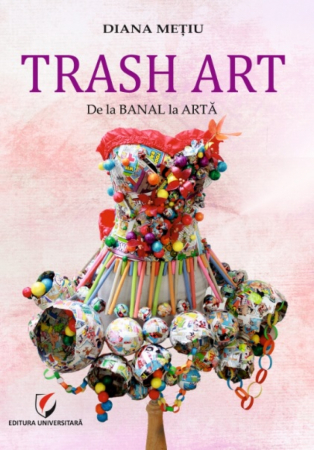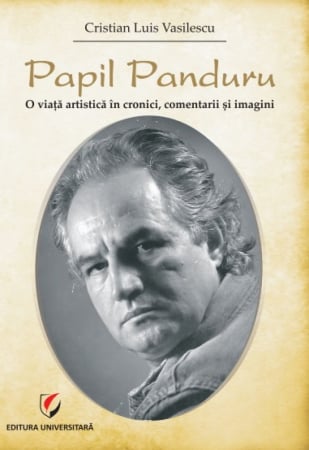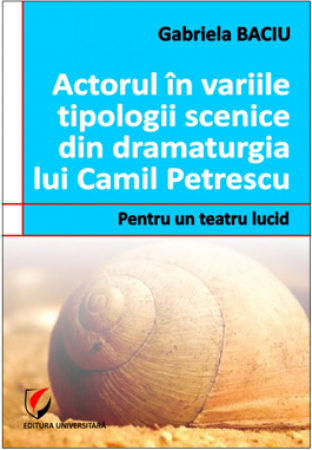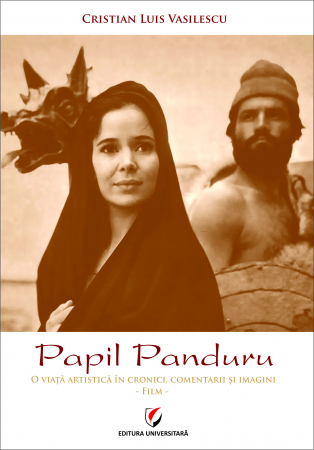ISBN: 978-606-28-0844-0
DOI: 10.5682/9786062808440
Publisher year: 2018
Edition: I
Pages: 220
Publisher: Editura Universitară
Author: Diana Vasile
- Description
- Download (1)
- Authors
- Content
- More details
- Reviews (0)
The stories in ˂video˃ games have a special nature compared to ordinary, linear stories, such as those in books or movies. They are stories that you interact with, are immersive, and in which, apparently, the player is in control through his actions. Thus, digital games are the new form of storytelling of the 21st century.
-
De la teatru la jocuri video. Structuri narative digitale
Download
Introduction / 7
I. Theater and high-tech evolution / 13
I. 1. Technological current - Technoculture from the Industrial Revolution to the Digital Revolution / 15
I. 2. a. The forerunners of high-tech and avant-garde theater / 17
I. 2. b. Space and time in art - Sequentiality and three-dimensionality / 21
I. 2. c. Real and virtual - Hybrid theater / 24
I. 2. d. Semiotics and the typology of images in the performing arts / 28
I. 3. From mixed-media theater to mixed-realities / 34
I. 3. a. The illusion of the presence in the digital arts / 37
I. 3. b. Virtuality and cyberspace / 41
I. 3. c. The video game as a show with an emphasis on participation and interaction / 51
I. 4. From analog theater to digital theater or from drama to cyberdrama / 60
II. The first forms of interactive and multilinear dramaturgy / 62
II. 1. The three-dimensional story and the metapostory / 67
II. 2. The fragmented story / 70
III. Digital Storytelling / 73
III. 1. What is a story? - Narration and linear structure / 80
III. 2. The illusion of multilinearity - Complex narratives and nonlinear structures / 86
III. 3. Ludologie vs. narratology or the transition from nonlinear to multilinear / 92
IV. Game Ludology / 97
IV. 1. Dramatic elements - interactive in the course of the game / 100
IV. 2. The convention of the game and its principles / 104
V. The types of narratives of the game / 113
V. 1. Linearity and multilinearity in the development of the game / 117
VI. Video game paradigm / 125
VII. Stages of video game development / 138
VII. 1. b. Research stage - Taxonomy of games / 140
VII. 2. Reference categories in video game taxonomy / 143
VII. 3. Production stage / 156
VII. 4. Practical stage: exercises / 157
VIII. The game with initiatory value / 162
VIII. 1. The stages of game development and stage play / 163
VIII. 2. Game functions / 165
VIII. 3. Game and creativity / 170
VIII. 4. The evolution of games / 174
IX. Perspectives on the digital environment in artistic pedagogy / 185
Case study: Skyrim - Applied Narrative Structures / 191
Conclusion / 200
Glossary / 204
ibliography / 213
The end of the 20th century and the beginning of the 21st century, ie the informational or digital age, is characterized by the transition from the traditional industry to the one based on computerized information. The digital revolution, also known as the Third Industrial Revolution, meant the transition from mechanical / analog to electronic / digital technology. Thus, most fields of activity have undergone transformations that have led to mutations between reality and virtuality: the need to use computer and mobile phone, the magnitude of the Internet phenomenon (Internet of things), wireless connection, virtual platforms (Oculus Rift, E.ON Icube) and video games. The computer and the smartphone are just some of the interfaces of virtual reality. Virtual reality simulated by computer processes has become a process used for more and more purposes (artistic, professional, therapeutic and medical). In certain professional environments (engineering, architecture, anthropology, archeology) virtual reality platforms are used to simulate the future project or to reconstruct the elements that existed, becoming navigable. In medical therapy, virtual reality platforms are also used to treat phobias and anxieties or for recovery from accidents (physical therapy). In the artistic environment we are talking about graphics tablets, sculptures and the network of physical objects, devices, means and other elements that have incorporated electronics, software, sensors and network connectivity and that allow these objects to collect and exchange data with each other (http : //www.itu.int/en/ITU-T/gsi/iot/)
E.ON Reality is the world leader in virtual and augmented reality based on knowledge of industry, education and fun education (edutainment = education & entertainment). The company is known for Icube, a virtual reality system based on four- or six-wall projection that becomes immersive thanks to high-performance glasses with motion sensors attached. (Https://www.eonreality.com/).
We could see that there is an ancient "theme of the virtual" that probably led to the emergence of cinema, but also the use of film in the show, as the projected image will always have the same effect on people, whether it is made with more old or newer.
In traditional shadow theater, the "virtual image" is the invoked spirit or divinity that emerges through the projection that is seen as a magical, mysterious operation. [...] For Athanasius Kirchner, the inventor of the magic lantern, projections are a means of provoking the emotion of spectators - a direction continued by the cinematic thriller. " In recent decades, theater has also been strongly influenced by cinema (film seen here as an art involving technology). Technological and multimedia means are increasingly present in theater performances, leading to a theater that I would call hybrid (a theater that undergoes a mutation following the meeting between theatrical reality and virtual reality), in which the possibilities of stage representation they are more comprehensive.
"Judging by the cold, it can be seen that theater has always been both technique and technology. It was an "environment" in the sense of a representation-specific technology, in which the latest media technology could be nothing more than a new chapter. In no case did the theater bring the man to the "foreground" naively, ignoring the technical arts. From the ancient mechané to the current high-tech theater, the delight of the theater has always meant the delight of a mechanic, the satisfaction of "functioning", of machine-precise intervention. It has always been a device that simulates reality with the help not only of acting, but also of theatrical machinery. Therefore, the theater immediately absorbed all new techniques and technologies, from the perspective to the Internet. The use of modern technical media: photography, projections, sound media, film in the theater, and in connection with refined lighting spaces and stage technique, began immediately after their discovery. "
"The fascination with technology is not a new theme in art. Futurists were so excited about technological progress that they used airplanes to make "drawings" in the sky with colored smoke.
"The subjects of "technoculture" (digitized art or which is subject to the technological process) were for me first passion due to the discovery of dystopian stories in literature. Then they became the subject of research in the field of film, continuing in the field of theater where dystopias are rare due to the nature of such stories. "A show like dystopian can be harder to conceive because it could contradict the laws of theater or drama. According to the Aristotelian definition of drama we understand: dialogue, action, conflict, the rule of the three units, climax, outcome, exposition of the subject in its conflictuality.
By its nature, the dystopian world presupposes a certain well-knit narrative and descriptive level of its universe, possible in literature and film due to their epic character, but quite difficult to apply in theater where the emphasis is mainly on action and conflict and not on description and narration.
Most of the dystopian stories that are projected into the tragic future touch on the theme of technological evolution to the detriment of human civilization. Thus, one can find a spectacular form of text that tends towards a high-tech theater, a multimedia, interactive or even virtual show. ”
Despite these aspects, dystopian worlds exist in theater both in terms of structured dramatic text (authors of dystopian theater: Karel Čapek, Caryl Churchill, Vladimir Sorokin, Mark Ravenhill, Alan Ayckbourn), as well as in spectacular forms present in current Romanian theater ( Catinca Draganescu with Dystopia (Shakespeare Remix, Alexandru Mihailescu with Cut and Concretes).
Therefore, this book represents on the one hand a continuation of these studies, on the other hand it also represents the result of a doctoral research; the common bridge of the two is the incorporation of digital technology in theatrical and cinematographic creation, aiming especially at dramatic and screenwriting.
The accumulation of personal knowledge in the field of theater and film, led the research to study theatricality in digital and virtual platforms (video games, interactive applications and platforms for virtual reality), but also the cinematic language found in this environment.
Also, the relationship being reciprocal, inevitably, we also analyzed the influence of multimedia / mixed media and new media in theater and film and the way in which the two arts developed new means of expression. In this interdisciplinary theater-film approach in the context of digital and virtual platforms, two essential elements of these two arts are combined: theater as a form of representation of the game (improvisation, interactivity, action, conflict) and film as audiovisual language (narrative, image and sound). Approaching a field by analogy is an easier way to understand new concepts and working principles. On the one hand, the technological means are more and more present in the theater, taking new and different forms of high-tech shows that must be analyzed and theorized. New technologies are also being developed for filming that require narrations, filming, editing different from the classic ones (360˚ filming). On the other hand, the video game industry is growing in importance and requires new skills and professions (from designers to engineers or developers) to make increasingly complex games. Thus, the study is also of public interest (spectators, players), professional and educational, directing the current offer on new directions of research and innovation, but also of collaboration between fields (engineering, psychology, architecture, etc.). The topic is current and is located in a research field that is developing, both worldwide, but especially nationally. “The video game industry in Romania is growing, and the studios in the country enjoy higher revenues in 2017 compared to the previous year. The turnover of the video game development industry increased by 11.6% in 2017, reaching 156 million dollars. 89% of this amount is made by the top 10 companies. Ubisoft, Electronic Arts Romania and Gameloft are the top three gaming companies locally. Fourth place is occupied by Amber Studio, a Romanian video game developer. Currently, in Romania, there are over 80 game development studios, of which over 50 are in Bucharest, and the rest in cities such as Cluj, Timisoara, Brasov, Craiova and Iasi. Therefore, over 6000 Romanians work in the country's studios of international companies or in independent studios with Romanian capital, their number increasing by 2% compared to 2016. Last but not least, the number of independent game developers in Romania continues to grow , as well as the success of the games it launches.
Ludology studies the mechanisms of the game and how they exist in the form of repeatable interconnected nuclei that are found in several subdomains of the game. For example, the mechanisms of board games (board games, card games, dice games, etc.) are largely applied in digital games, with the difference that they are encoded in the programming language. Thus, the interactivity, but especially the participation, the primordial characteristics of the game, were rediscovered with the new technologies. From computers to ATMs, from smartphones to other smart devices, they all use the same principles of interaction, found in the game's mechanisms: action and multiple responses to action, providing a goal and fulfilling it by predetermined rules. Understanding these basic rules of operation of interactivity from the game leads to their extension in the field of interactive art (installations, digital performance, interactive applications, virtual reality, etc.) and many categories of games (analog17 and digital).
In fact, games (especially video games) have become references to general culture, such as books and movies. Why? Because they also tell stories. They are the new form of storytelling of the 21st century. However, video game stories have a special nature compared to ordinary, linear stories, such as those in books or movies. They are stories that you interact with, are immersive and in which, apparently, the player is in control through his actions.
One of the central elements of the research I propose (with historical and theoretical support) is the study of a narrative with applicability to contemporary art forms that involve digital and virtual. The development of the digital environment achieves a new synthesis of storytelling: interactive and multilinear storytelling. This study of multilinear narrative is useful both in terms of contemporary innovations in the field of dramatic writing (for interactive, digital or virtual shows), of cinematic storytelling (interactive film, expanded cinema and 360˚ film), and for the development of ways of functioning of new digital languages that interact with written forms (games, digital applications, augmented reality / AR19 or virtual / VR20, etc.). Also, the analysis of multilinear story structures is still in its infancy, therefore, game stories are still poorly developed narratively. Seriously studying all these components (structures, rules, mechanics) and functions of the game can deliver a professional and qualitative content in games and can develop the cognitive qualities of the players.
The research is put on the page following two major lines: the chronological and historical line of technological and interactive manifestations in theater and narrative structures and the evolution of construction and expression mechanisms from analog to digital forms in theater and video games.
The author
Autoarea

6359.png)
![From Theater to Video Games. Digital Narrative Structures - Diana Vasile [1] From Theater to Video Games. Digital Narrative Structures - Diana Vasile [1]](https://gomagcdn.ro/domains/editurauniversitara.ro/files/product/large/de-la-teatru-la-jocuri-video-structuri-narative-digitale-201-71473.jpg)

